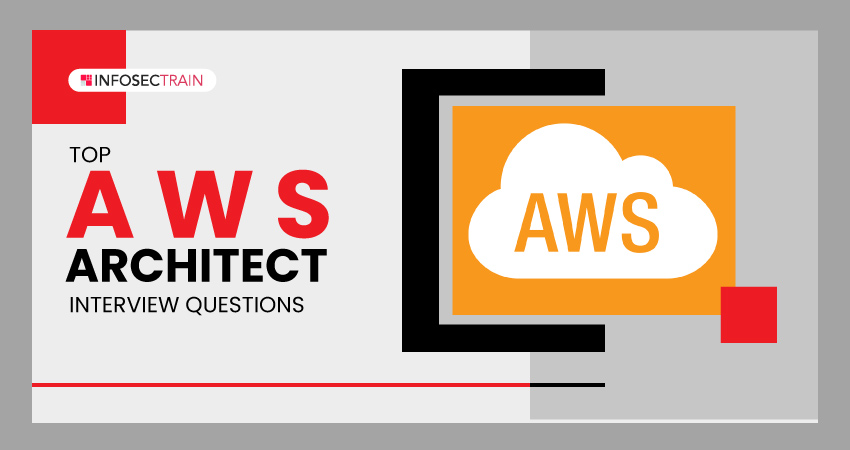Top AWS Architect Interview Questions
Amazon Web Services (AWS) is the popular and frequently used cloud computing platform that provides businesses with highly reliable, scalable, and affordable cloud services. Many companies are actively hiring cloud professionals; undoubtedly, the AWS Architect role is one of the most sought-after IT roles in recent years.

This article will provide you with the top AWS Architect interview questions to assist you in succeeding in your interview and landing your ideal job as an AWS Solution Architect. AWS Architects are among the highest-paid professionals in the IT industry. Below is a list of the top frequently asked AWS Architect interview questions and answers.
1. What are the main components of AWS?
The main components of AWS are:
- Elastic Block Store (EBS)
- Elastic Compute Cloud (EC2)
- Elastic Load Balancing (ELB)
- CloudWatch
- Identity and Access Management (IAM)
- Route 53
- Simple Email Service (SES)
- Simple Storage Service (S3)
- Virtual Private Cloud (VPC)
2. What does an AMI contain within AWS?
The following elements are part of an AMI:
- A template for the instance’s root volume.
- A block device mapping to decide which volumes should be attached to the instance when it is launched.
- Launch permissions to determine which AWS accounts are permitted to use the AMI to launch instances.
3. How many buckets may be created by default in AWS?
Up to 100 buckets may be created by default for each AWS account.
4. What exactly are key pairs in AWS?
Key pairs are the credentials that are used to access Amazon EC2 Instances securely. Key pairs include public and private keys when connecting to an Amazon EC2 instance.
5. Which AWS services would you employ to collect and process e-commerce data for real-time analysis?
- Amazon DynamoDB
- Amazon Redshift
6. What are the benefits of auto-scaling?
The benefits of auto-scaling are:
- Enhanced fault tolerance
- Sustain performance automatically
- Higher availability
- Optimal cost management
- Make reasonable scaling decisions
7. What factors should you consider while choosing an availability zone?
There are several factors to consider, some of them are:
- Cost
- Latency
- Compliance
- Availability of services and features
8. How can a request be sent to Amazon S3?
Amazon S3 is a REST service; requests are sent using the REST API or the AWS SDK wrapper libraries encapsulating the basic Amazon S3 REST API.
9. Can we use only one Elastic IP address to host several websites on the EC2 server?
No, it is not typically possible. In such a circumstance, we require multiple elastic IPs. Also, it can be done via some specific OS capabilities in certain scenarios.
10. Define AWS CloudTrail?
AWS CloudTrail is a service that provides logs of AWS API calls and associated events for auditing and compliance purposes. It enables customers to track changes to their AWS resources and understand who made those changes, what actions were taken, and when they were taken.
11. What is the S3 default storage class?
In S3, the S3 Standard is the default storage class.
12. Describe SQS in terms of AWS.
Amazon Simple Queue Service (SQS) allows you to send, store, and receive messages between multiple software components at any amount without losing the original messages.
13. What distinguishes Redshift, DynamoDB, and Amazon RDS?
Redshift is an entirely managed data warehouse service used in data analysis, and it is a fast, robust, and scalable cloud service.
DynamoDB is a serverless, fully-managed NoSQL database service that works with unstructured data. It is designed to execute high-performance applications of any size.
Amazon RDS is a managed database service offered by AWS. It makes it easy to configure, operate, and scale a relational database in the cloud. It supports multiple database engines, including Amazon Aurora, MySQL, MariaDB, Microsoft SQL Server, Oracle, and PostgreSQL.
14. Which subnet is best for launching database servers?
The private VPC subnet should be chosen for launching database servers over the public subnet.
15. What are the key features of Amazon CloudSearch?
Amazon CloudSearch is a fully managed cloud solution for websites or applications.
Some of Amazon CloudSearch’s important features are listed below:
- Range search
- Boolean search
- Prefix search
- Highlighting
- Complete text search
- Autocomplete suggestion
16. Which services are used to deploy an application in AWS?
Services used to deploy an application include:
- AWS Elastic Beanstalk
- AWS EC2
- AWS Lambda
- AWS Fargate
- AWS Lightsail
- AWS CloudFormation
17. List the types of load balancers in AWS services.
Different types of load balancers are used in AWS services:
- Application Load Balancers
- Network Load Balancers
- Classic Load Balancers
- Gateway Load Balancers
18. What services can be utilized to gather and process data for e-commerce?
The best services are Amazon Redshift and Amazon DynamoDB. Data from e-commerce websites are typically presented in an unstructured way, so we can employ both because they are both beneficial for unstructured data.
19. What are the different Amazon S3 storage classes available?
Amazon S3 offers the following storage classes:
- S3 Standard
- S3 Standard-Infrequent Access (S3 Standard-IA)
- S3 Intelligent-Tiering
- S3 One Zone-Infrequent Access (S3 One Zone-IA)
- S3 Glacier Instant Retrieval
- S3 Glacier Flexible Retrieval (formerly S3 Glacier)
- S3 Glacier Deep Archive (S3 Glacier Deep Archive)
- S3 Outposts
20. What network performance parameters should you anticipate launching instances in a cluster placement group?
Depending on the type of instances and the network performance specification, you can anticipate the following parameters if you launch in a placement group:
- Up to 10 Gbps in a single flow
- 20 Gbps in full-duplex or in multi-flow
- Outside the group network, traffic is limited to 5 Gbps
For more AWS Architect interview questions, you can also check out:
- Top interview questions for AWS Solutions Architect
- Top AWS Architect Interview Questions In 2022
- Top 25 AWS Interview Questions
How can InfosecTrain help you?
I hope you enjoyed reading these AWS Architect interview questions and answers. We at InfosecTrain are here to assist you with your journey toward becoming an AWS Solution Architect. InfosecTrain offers preparation courses for the AWS Certified Solutions Architect-Associate and AWS Certified Solutions Architect-Professional certifications. Through these courses, you will enhance your technical knowledge and expertise in designing distributed systems on the AWS platform with the help of industry experts, which will also help you understand how to architect and develop secure and robust applications.







 1800-843-7890 (India)
1800-843-7890 (India)